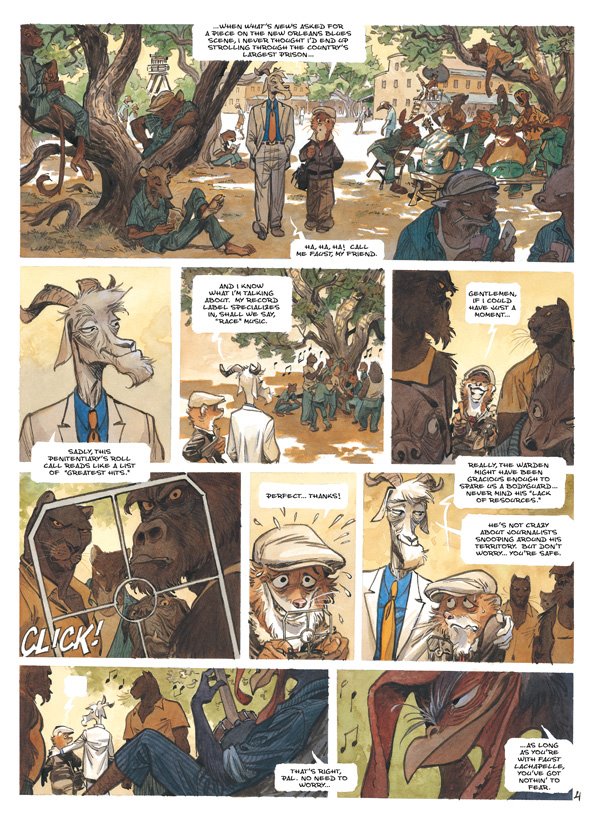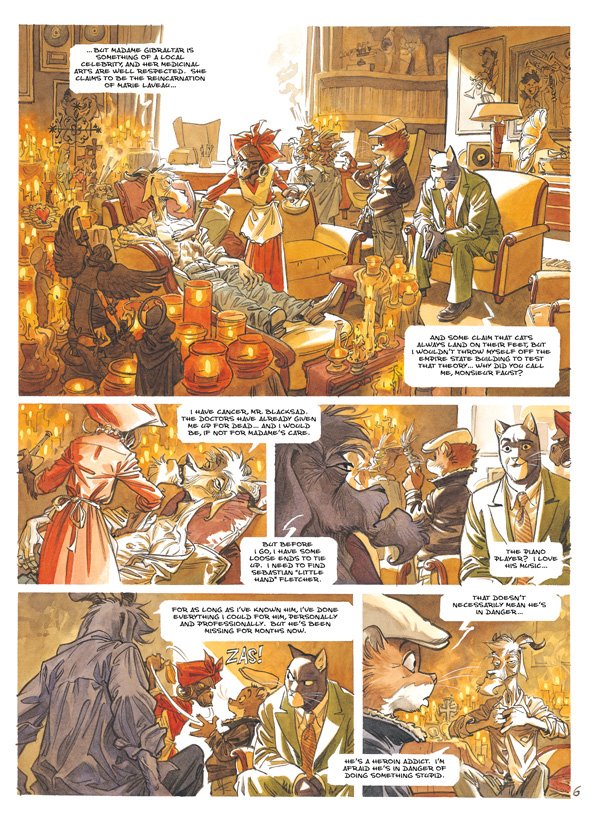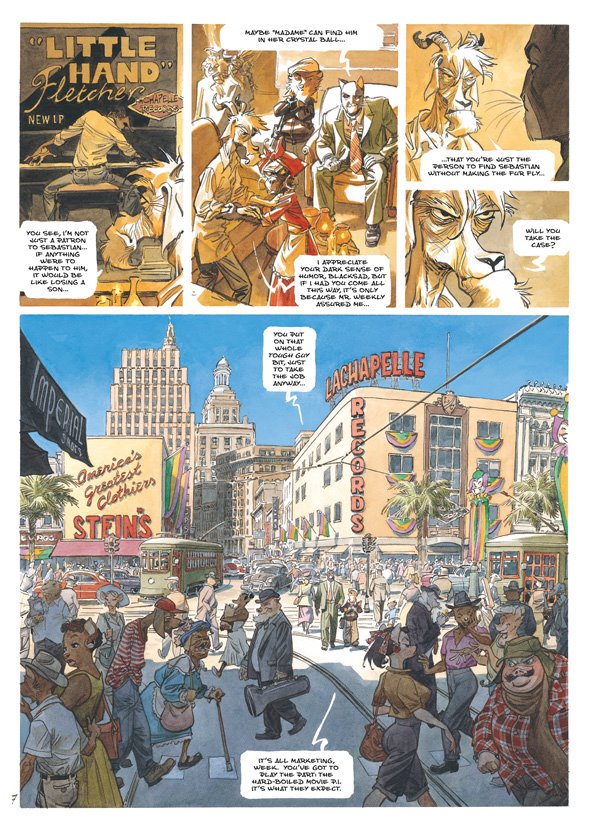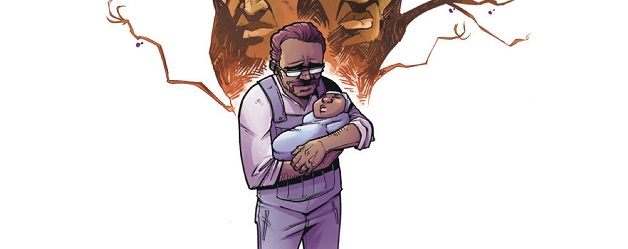 Blacksad: A Silent Hell
Blacksad: A Silent Hell
Publisher: Dark Horse
Writer: Juan Diaz Canales
Artist: Juanjo Guarnido
Release Date: July 11, 2012
Did you know that the latest and strongest noir story is not found in a pulp magazine, nor on a hard-broiled cop drama on television? No, the strongest noir today doesn’t even have humans in it. I’m dead serious. As great as Darwin Cooke’s Parker adaptations are, they don’t hold a candle to Canales and Guarnido’s noir masterpiece Blacksad.
I don’t use the word “masterpiece” very often, if at all. But if you read the first Blacksad book published in the United States by Dark Horse, you know that “masterpiece” is no hyperbole. Everything you could want in a crime drama is there–a great lead private investigator, an intriguing and plot-twisting story, a bunch of shady villains, a beautiful dame, a hilarious side-kick, and some exciting action and murder.
 This book continues the story of Detective John Blacksad, which has him and his trusty reporter sidekick Weekly on the case of a missing blues musician in 1950s New Orleans. Hired by a record producer to find the missing musician, Blacksad quickly finds himself in the middle of a scandal 30 years in the making. No one is ever quite who they seem in a Blacksad book, and Canales develops characters so well that you equally sympathize with the villain as well as the hero. This book has all the mystery and wonder that a story set in New Orleans can have.
This book continues the story of Detective John Blacksad, which has him and his trusty reporter sidekick Weekly on the case of a missing blues musician in 1950s New Orleans. Hired by a record producer to find the missing musician, Blacksad quickly finds himself in the middle of a scandal 30 years in the making. No one is ever quite who they seem in a Blacksad book, and Canales develops characters so well that you equally sympathize with the villain as well as the hero. This book has all the mystery and wonder that a story set in New Orleans can have.
But I have left out one extremely important point, which you can easily forget, because it blends so well into the world of Blacksad…the characters are all anthropomorphic animals. Imagine Disney’s Robin Hood, and throw all those characters into a noir book, and you have Blacksad summed up. But I would say that Canales and Guarnido do an even better job of using the technique of anthropomorphism than Disney ever has. These are not just cute animals assigned to characters at random. Nor are they as overt representations that you might find in Maus. Instead, when reading Blacksad, you get the sense that the animal chosen for a character was not only done so carefully, but Guarnido’s art capitalizes on the look of the animal completely to tell you visually exactly what this character is like.
 Have you ever looked at a person and thought, “if s/he was an animal, I bet s/he’d be a (fill in the blank)”? Guarnido takes Canales’s script and does just that, not just arbitrarily drawing a dog face on a human body. Instead, you can tell the amount of research Guarnido does to match the species of the character to their persona. One of the best examples in this book is that of the missing musician/heroin-addicted Sebastian. He is drawn as a hound dog with all the innocence that a hound dog can have, with large brown eyes and floppy jowls. But in the next panel, he can be savage, like a mutt deprived of food, emaciated and vicious. Through his art, Guarnido says, “a heroin addict in major trouble is like an abused hound dog.”
Have you ever looked at a person and thought, “if s/he was an animal, I bet s/he’d be a (fill in the blank)”? Guarnido takes Canales’s script and does just that, not just arbitrarily drawing a dog face on a human body. Instead, you can tell the amount of research Guarnido does to match the species of the character to their persona. One of the best examples in this book is that of the missing musician/heroin-addicted Sebastian. He is drawn as a hound dog with all the innocence that a hound dog can have, with large brown eyes and floppy jowls. But in the next panel, he can be savage, like a mutt deprived of food, emaciated and vicious. Through his art, Guarnido says, “a heroin addict in major trouble is like an abused hound dog.”
Guarnido’s art is what puts this book over for me into the “masterpiece” category. He really is a former Disney animator, so he draws in that style that is slick and stylized. His work is the epitome of cartooning. His characters carry themselves with every fluid, exaggerated movement a cartoon character has, but not in a completely unrealistic way. His cinematic shots prove that he has the chops of someone who has been on the director’s side of a camera.
 Every panel has extreme detail, from backgrounds to wrinkles on a face. One panel in particular had my jaw on the floor. Blacksad is chasing someone and runs right into a New Orleans parade. The shot is a wide one of the entire scene. If you’ve ever seen a Mardi Gras parade, you know how colorful and diverse an image that can be. Guarnido draws every single face with precision. Every character in that image has a story based on Guarnido’s rendering. It’s a truly breathtaking piece of art.
Every panel has extreme detail, from backgrounds to wrinkles on a face. One panel in particular had my jaw on the floor. Blacksad is chasing someone and runs right into a New Orleans parade. The shot is a wide one of the entire scene. If you’ve ever seen a Mardi Gras parade, you know how colorful and diverse an image that can be. Guarnido draws every single face with precision. Every character in that image has a story based on Guarnido’s rendering. It’s a truly breathtaking piece of art.
Not only does Guarnido draw this book, but he also watercolors it. How in the hell do you watercolor a realistic-yet-cartoony book? Well, this book tells you, with an art book inside detailing Guarnido’s process for watercoloring the book. Not only is this book entertaining, it’s educational. Art enthusiasts should buy this book even if they don’t like noir or cartoons. Guarnido’s watercolors make this world subdued and dingy. The watercolors muddy the lights and the darks, which is the perfect kind of coloring for a noir book. If this was digitally colored with a bright, Disney-esque palette, the tone of the book would be lost. Yet Guarnido shows us that fine watercoloring can be the perfect tool for a noir story.
I could not put this book down, and devoured it quickly even though it is a 54-page story. I went back and stared at various panels again and again, studying every aspect. It’s a sequential art feast. This book gets my highest recommendation, and you should pre-order it immediately.
Rating: 5/5
Jeff Jackson
jeff@comicattack.net
@FrJeffJackson


